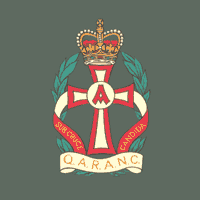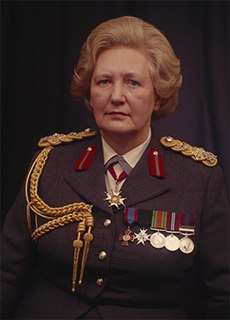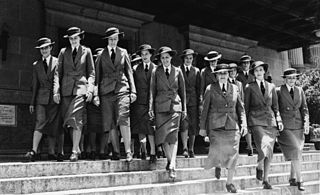
The First Aid Nursing Yeomanry is a British independent all-female registered charity formed in 1907 and active in both nursing and intelligence work during the World Wars. Its members wear a military-style uniform, but it is not part of the Regular Army or Army Reserve; members do not train at Sandhurst, nor do they hold a commission.

Colonel Matron Kathleen Annie Louise Best, was the first director of the Women's Royal Australian Army Corps.

Most professional militaries employ specialised military nurses. They are often organised as a distinct nursing corps. Florence Nightingale formed the first nucleus of a recognised Nursing Service for the British Army during the Crimean War in 1854. In the same theatre of the same war, Professor Nikolai Ivanovich Pirogov and the Grand Duchess Yelena Pavlovna originated Russian traditions of recruiting and training military nurses – associated especially with besieged Sevastopol (1854–1855). Following the war Nightingale fought to institute the employment of women nurses in British military hospitals, and by 1860 she had succeeded in establishing an Army Training School for military nurses at the Royal Victoria Military Hospital in Netley, Hampshire, England.

Queen Alexandra's Royal Army Nursing Corps is the nursing branch of the British Army and part of the Army Medical Services.

Dame Emma Maud McCarthy, was a nursing sister and British Army matron-in-chief.

The Indian Military Nursing Services is a part of Armed Forces Medical Services (AFMS) of the Indian Army, first formed under British rule in 1888. An officer in the Military Nursing Services is granted Permanent Commission or Short Service Commission by a Govt Gazette Notification. The list of names are published in the weekly gazette of Government of India from time to time.

Brigadier Helen S. Cattanach was a British military nurse and nursing administrator who served as Director of British Army Nursing Services (DANS) and Matron-in-Chief of Queen Alexandra's Royal Army Nursing Corps from 1973 to 1977.

Dame Sidney Jane Browne, was the first appointed Matron-in-Chief of the newly formed Queen Alexandra's Imperial Military Nursing Service (QAIMNS). After she retired from the QAIMNS she was appointed as Matron-in-Chief of the Territorial Force Nursing Service. Browne was appointed a Dame Grand Cross of the Order of the British Empire in 1919 and, in 1922, she became the first President of the Royal College of Nursing, a post she held until 1925.
Caroline Keer, was a British military nurse and nursing administrator, who served in Natal during the Second Boer War.
Army nursing may refer to:

The role of Australian women in World War I was focused mainly upon their involvement in the provision of nursing services. Australian women also played a significant role on the homefront, where they filled jobs made vacant by men joining the armed forces. Women also undertook fundraising and recruiting activities as well as organising comfort packages for soldiers serving overseas. Around the issue of conscription, women were involved in campaigning on both sides of the debate, while they were also equally involved in the New South Wales strike in 1917. Nevertheless, despite this involvement, women have never occupied a central position in the Australian version of the ANZAC myth, although since the 1970s their role has been examined in more detail as a result of the emergence of feminist historiography, and specialist histories such as the history of nursing.
Dame Louisa Jane Wilkinson, was a British military nurse and nursing administrator who served as Matron-in-Chief of the Queen Alexandra's Imperial Military Nursing Service (QAIMNS) from 1944 to 1948. She founded Queen Alexandra's Royal Army Nursing Corps (QARANC), and was also president of the Royal College of Nursing.

Grace Margaret Wilson was a high-ranked nurse in the Australian Army during World War I and the first years of World War II. Wilson was born in Brisbane, and completed her initial training as a nurse in 1908. After the outbreak of World War I she joined the Australian Army Nursing Service (AANS) and subsequently transferred to the First Australian Imperial Force. From 1915 until 1919 she was the principal matron of the 3rd Australian General Hospital. She served as the temporary matron-in-chief in the AIF Headquarters, London from late 1917 until early 1918. Wilson returned to Australia in 1920 and left the AIF to work in civilian hospitals. She was appointed the matron-in-chief of the AANS in 1925, and in September 1940 joined the Second Australian Imperial Force. She served in the Middle East until August 1941, when she returned to Australia due to ill health. She left the Army the next month, but from September 1943 worked in the Department of Manpower Directorate (Victoria)'s nursing control section.

The Australian Army Nursing Service (AANS) was an Australian Army Reserve unit which provided a pool of trained civilian nurses who had volunteered for military service during wartime. The AANS was formed in 1902 by amalgamating the nursing services of the colonial-era militaries, and formed part of the Australian Army Medical Corps. During World War I, more than 2,286 women joined the AANS AIF for overseas service. Many of them served in Casualty Clearing Stations. Hundreds more served in the AANS AMF on home service in Australia. After WWI, the AANS reverted to a Reserve. The AANS was mobilised again during World War II, and many of its members served overseas. Following the war several AANS nurses were posted to Japan as part of the British Commonwealth Occupation Force. The service was renamed the Royal Australian Army Nursing Service (RAANS) in November 1948 and became part of the regular Army the next year. In 1951 the RAANS achieved corps status, and became the Royal Australian Army Nursing Corps.
The timeline of nursing history in Australia and New Zealand stretches from the 19th century to the present.
The history of nursing in the United Kingdom relates to the development of the profession since the 1850s. The history of nursing itself dates back to ancient history, when the sick were cared for in temples and places of worship. In the early Christian era, nursing in the United Kingdom was undertaken by certain women in the Christian Church, their services being extended to patients in their homes. These women had no real training by today's standards, but experience taught them valuable skills, especially in the use of herbs and folk drugs, and some gained fame as the physicians of their era. Remnants of the religious nature of nurses remains in Britain today, especially with the retention of the job title "Sister" for a senior female nurse.

Alys Ross King, known as Alice Ross-King, was an Australian civilian and military nurse who took part in both World Wars. She has been described as Australia's most decorated woman. During the First World War she served in hospitals in Egypt and France and was one of only seven Australian nurses decorated with the Military Medal for gallantry. In the Second World War she held a senior post within the Australian Army Medical Women's Service. In 1949 she was awarded the Florence Nightingale Medal, the highest award made by the International Committee of the Red Cross.
Beatrice Isabel Jones, was a British nurse who, after serving in several civilian hospitals, volunteered for military service. She served in the Second Boer War in South Africa and then later served during the First World War in Baghdad as matron-in-chief of Mesopotamia. She was one of the inaugural recipients of the Florence Nightingale Medal.

Dame Ethel Hope Becher was a British nurse who served as the War Office matron-in-chief of the Queen Alexandra's Royal Army Nursing Corps from 1910 to 1919, including World War I.













